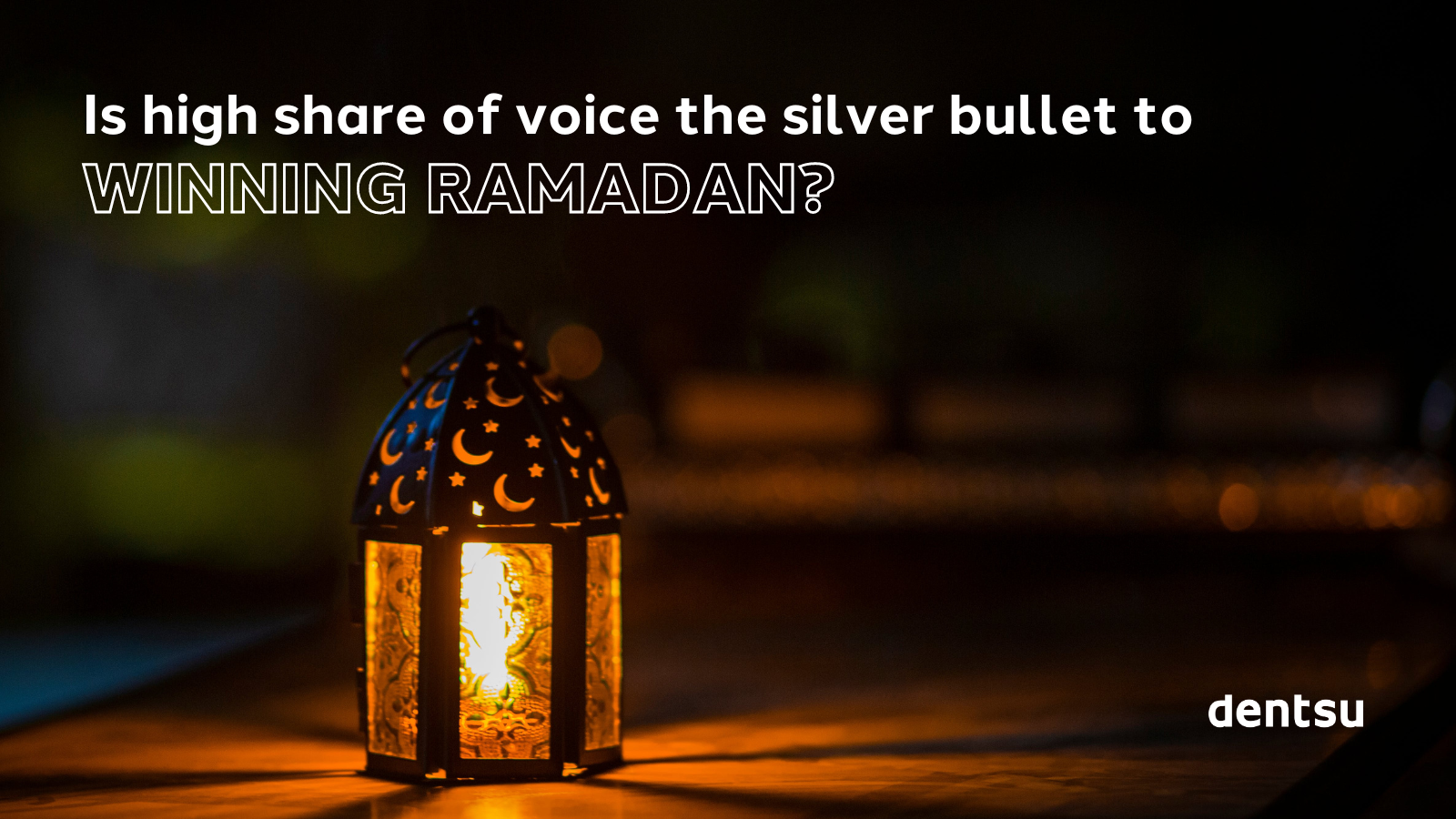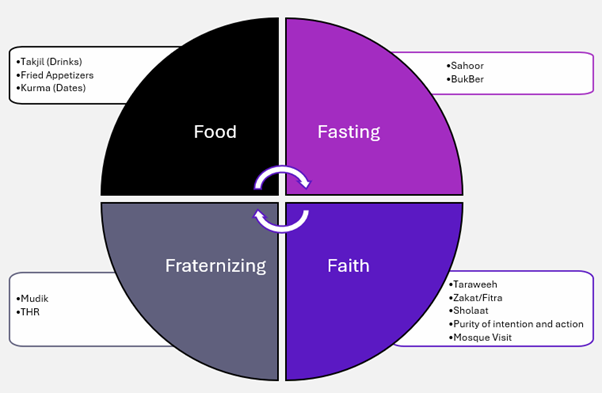
Ramadan is a time of spiritual reflection, religious devotion and community building for Muslims all around the world. With 87% of its 280-odd million population identifying as Muslim, Indonesia is the most populous Muslim country in the world and thus, the month of Ramadan and its ensuing culmination with Eid or Lebaran, assumes gargantuan proportions.
The festive vibes, higher propensity to spend and an overall rise in positivity makes the Ramadan period critical for marketers to connect with consumers, build brand resonance and capture greater share of wallet.
Ramadan in Indonesia is characterised by the 4Fs: fasting, feasting, fraternising and faith.

Food
Ramadan consists of fried and sweet delicacies often prepared as snacks to break fast during iftar time. In the spirit of goodwill, some tend to provide takjil, or snacks, to the needy besides buying for themselves.
This tends to see a burst of food research, increasing by 25% during this period, according to the Google “Navigating Ramadan” report, which also states that e-commerce usage is expected to increase by 75% during the month of Ramadan.
Meanwhile, offline shopping expenditures are expected to increase by 41% for snacks, soft drinks, food staples and hampers/parcels (Dentsu Consumer Connection Survey 2023).
Fasting
The crux of Ramadan is fasting from dawn to dusk, eating only before sunrise and after sunset. This leads to significant changes in the daily schedule of Indonesians, creating new prime-time media consumption occasions at daybreak, sunset and post-evening prayers.
Faith
In addition to fasting throughout the day, Muslims are expected to spend time strengthening their faith, via prayers, going to the mosque, giving charity and increasing their good deeds.
Indonesians tend to abstain from all things negative and remain steadfast on the right path for this month.
Fraternizing
Finally, Ramadan followed by Lebaran is also a period of socialising with friends and family, going for fast-breaking feasts, praying together, and gifting electronics and food hampers.
During this period, Indonesians are also known to participate in Mudik, a yearly mass migration where millions travel from cities back to their hometowns to celebrate Eid al-Fitr. Estimated to involve 30 million people in 2022, it is considered the world's largest annual human migration (Mobility Data).
Another important consideration here is the government-mandated annual bonus, called THR or Tunjangan Hari Raya, for all skilled and unskilled workers. This further stimulates consumer spending during the holiday period.
These 4Fs break down the micro-moments for brands to connect with Muslim consumers. By understanding these cultural nuances and tailoring their communication, marketers can successfully tap into the heightened spending potential and build meaningful brand relationships during this important period.
Share of voice and winning Ramadan
Considering the weight that the holy month carries towards the total annual sales for brands, there is a propensity to channel efforts towards maximising the share of voice during Ramadan in Indonesia. However, a loud and ubiquitous presence isn't necessarily the right starting point for success.
While there's no denying the role of visibility and SOV for brand awareness and building top-of-mind metrics, this cannot be the sole focus of the marketing campaign. The intense competition and the natural tendency to outshout your competition leads to an average of 10-25% increase in inventory costs across traditional as well as digital mediums (Dashboard learning and advertiser rate card). This means that advertising beyond a certain point in the cluttered ad space will lead to diminishing ROI, whilst also risking consumer ad fatigue.
Ramadan shoppers are motivated by factors beyond mere awareness. Building trust, connection to traditions and offering value become more crucial for driving purchase decisions. According to Dentsu’s Consumer Connection Survey 2023, 77% of Indonesians claim that they would be willing to pay a premium for a brand that resonates with their cultural heritage and values.
Making every interaction count
While achieving a certain level of brand awareness is necessary during Ramadan, marketers must also prioritise delivering the right message, at the right time, within the right environment. This means going beyond traditional mass media and utilising a strategic mix of channels for optimal impact.
This also means that brands which do not have huge war chests cannot vie for their share in Ramadan. But done smartly, even a niche brand with a limited budget can create a big impact and punch above its weight.
A popular confectionary brand wanted to associate itself as a preferred fast-breaking option but did not have the budget to advertise on mass media. It thus pivoted towards food delivery apps, which see about a 150% increase in daily active users (Data.ai), especially closer to the fast-breaking time.
During this period, the brand flooded the app with banner ads, building consideration for itself as the convenient and valuable “fast-breaking” option. It also partnered with select restaurants to deliver customised recipes made with the brand and promoted these restaurants/dishes across the platform. This helped to build the brand preference and relevance, ultimately leading to a 50 bps increase in the category market share for the brand without spending on an awareness platform.
Another example is a popular ready-to-drink coffee brand, which decided to leverage Mudik to establish itself as the perfect refreshing beverage for the journey home. The brand hijacked some of the busiest rest areas and train stations across Java with hoardings, wall paintings focused towards Mudik-specific messaging and limited edition Ramadan cans, which were sold by the shops at the rest areas. Thus, there was a direct connection with the audiences, who saw the brand as the most preferred journey companion.
The brand managed to find the most fertile and relatively clutter-free space to connect itself with consumers through a relatable message and product. Brand lift studies showed an unbelievable 91% increase in purchase intent during/after the campaign period, making the brand an integral part of an important Indonesian custom.
Another ready-to-drink brand leveraged Mudik digitally. Observing an average usage increase of 49% of digital map apps during the Mudik period (Data.ai), the brand partnered with Waze, a popular map app in Indonesia, to reach out to their audiences during their travel and send strategic notifications when they passed any location that had a store stocking the product. This campaign was able to yield a +2 uplift in purchase intent and +3 uplift in brand consideration.
We thus see enough and more examples of brands doing it right, whether by using the right moment, the right placement, the right message or a combination of these to create bespoke experiences for consumers, without a barrage of constant brand communication. The secret to winning Ramadan lies not in maximising the number of brand interactions but in making every interaction with the brand special and memorable.
The writers are Hasya Petranto, Associate Programmatic Manager, dentsu Indonesia; and Faheem Merchant, AOR director, dentsu Indonesia. This article originally appeared in WARC Exclusive.

